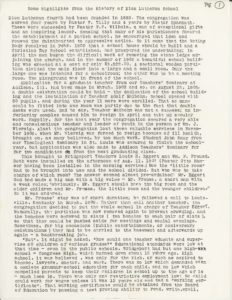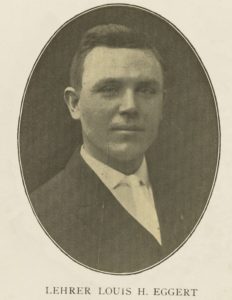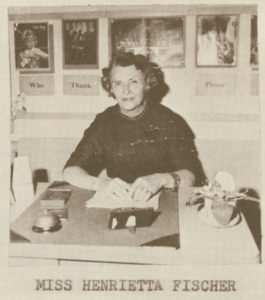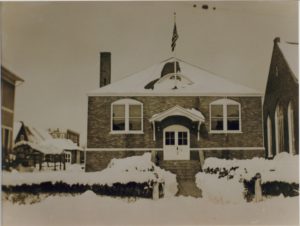School History
Around 1959 Former Principal & Teacher of Zion Lutheran School, Louis H. Eggert, was asked to write a History of the school.
Some highlights from the History of Zion Lutheran School

Zion Lutheran Church had been founded in 1892. The congregation was served for four years by Pastor F. Tilly and 4 years by Pastor Spannuth. These were succeeded by Pastor F. P. Wilhelm, a man of exceptional gifts and an inspired leader. Sensing that many of his parishioners favored the establishment of a parish school, he encouraged that idea and roused the fainthearted to aggressive action. So it came that the Voting Body resolved in Febr. 1902 that a school house should be built and a Christian Day School established. God prospered the undertaking; in April the men began the difficult work of removing the stone ledge adjoining the church, and in the summer of 1903 a beautiful school building was erected at a cost of only $3,322.00. A sectional wooden partition dividing the main floor into a large and small room. Only the large room was intended for a schoolroom; the other was to be a meeting room. The playground was in front of the school.

from 1916 program
Application for a graduate teacher from our Teachers’ Seminary at Addison, Ill. Had been made in March, 1903 and so, on August 23, 1903 a double celebration could be held – the dedication of the school building and the installation of Teacher Adolf Meibohm. School opened with 50 pupils, and during the year 11 more were enrolled. That so many could be fitted into one room was partly due to the fact that double desks were used. Sad to say, Teacher Meibohm was not a success; and inferiority complex caused him to resign in April and take up secular work. Happily, for the next year the congregation secured a very able and conscientious teacher and leader of youth in the person of Wm. J. Wiersig. Alas! The congregation lost these valuable services in November of 1906, when Mr. Wiersig was forced to resign because of ill health, brought on, as many believed, by too much work. Student John Baur from our Theological Seminary in St. Louis was secured to finish the school year, but application was also made to Addison Teachers’ Seminary for two candidates from the next graduating class.

(Teacher Eggert on Left)
This brought to Bridgeport Teachers Louis H. Eggert and Wm. F. Preuss. Both were installed on the afternoon of Aug. 11, 1907 (Pastor Otto Hanser having been installed in the morning service.) Now the “little room” had to be brought into use and the school divided. But who was to take charge of which room? The answer seemed almost pre-ordained: Mr. Eggert was a big man with a big voice – Mr. Preuss, a short man with a weak voice; “obviously, Mr. Eggert should have the big room and the older children and Mr. Preuss, the little room and the younger children.” So it was ordered.
Mr. Preuss’ stay was of short duration; he followed a call to Louisville, Kentucky in March, 1908. Rather than call another teacher, the congregation decided to put the whole school in charge of Teacher Eggert. Naturally, the partition was now removed again to prevent crowding, and the benches were screwed to slats (two benches to each pair of slats), so that they could be pushed aside for meetings and social evenings. Sometimes, for big occasions (public entertainments, of anniversary celebrations) they had to be carried to the basement and afterwards up again – a backbreaking job.
“But”, it might be asked, “how could one teacher educate and supervise 60 children of various grades?” Education standards were low at that time – even in the public schools. Bridgeport had but one high-school – Congress High, which burned down about 15 years ago. High school, it was believed, was only for the rich, or such as aspired to become, lawyers, doctors, and such. There was no law which demanded even a complete grammar-school education for each child, and no law which compelled parents to keep their children in school up to the age of 14 – much less 16. There was only one restrictive employment law: No child could work for wages unless it was 12 years old and had a “working certificate”. That working certificate could be obtained from the Board of Education by passing a test proving ability to read, white, spell, and “do fractions”. Shops and stores accepted these children as apprentices and therefore felt justified in paying them miserable wages “while learning”.
 Our school not only did a creditable job teaching the elementary subjects but, in addition, taught Bible History, Catechism, and German. Yes, the latter had to be taught so that the other two could be taught. Nearly all of our Lutheran congregations were German. Our textbooks in Bible History and Catechism were German. So, to prepare our children for future church membership, we taught German Reading (Fibel, Erste Lesebuch, and Zweites Lesebuch), German Language (Erstes and Zweites Uebungsbuch) and German Script. This was not to difficult in the first years. Most of our parishioners hailed from Germany or just across the border therefrom, kept pretty much to themselves, and spoke German in their homes. But as the parents “picked up” the English language, less and less German was spoken in the homes, and soon we were teaching German as a strange language. Imagine what a problem it became to teach Religion by means of the German language – and for the pupils to learn Religion. As a result, by 1927 English had become the means of instruction in Religion; nevertheless, the demand for instruction in German reading continued until 1944.
Our school not only did a creditable job teaching the elementary subjects but, in addition, taught Bible History, Catechism, and German. Yes, the latter had to be taught so that the other two could be taught. Nearly all of our Lutheran congregations were German. Our textbooks in Bible History and Catechism were German. So, to prepare our children for future church membership, we taught German Reading (Fibel, Erste Lesebuch, and Zweites Lesebuch), German Language (Erstes and Zweites Uebungsbuch) and German Script. This was not to difficult in the first years. Most of our parishioners hailed from Germany or just across the border therefrom, kept pretty much to themselves, and spoke German in their homes. But as the parents “picked up” the English language, less and less German was spoken in the homes, and soon we were teaching German as a strange language. Imagine what a problem it became to teach Religion by means of the German language – and for the pupils to learn Religion. As a result, by 1927 English had become the means of instruction in Religion; nevertheless, the demand for instruction in German reading continued until 1944.

At the time of her retirement 1960
In 1915, Pastor H. D. Wehmeyer began his long and successful pastorate of 40 years in Zion. One of these successes was the expansion of our school to two rooms, with Miss Henrietta Fischer as teacher of the three lower grades. This enabled us to raise the standard of our school so that our graduates, if recommended, were accepted into the 9th grade without examination. There they have consistently made good records in scholarship and conduct.

After 1921 remodel
1921 was Zion’s great banner year, when our church and school were rebuilt and enlarged, and the latter was raised and moved farther back. The lot behind the school, which we had purchased in 1910, now became the playground, and the school-rooms were fitted out with new, single, adjustable desks.
In 1934, the adjoining lot north of our property was purchased to furnish parking space for cars and additional playground. The most recent alteration for the improvement of the school-building was the erection of a new entranceway, intended especially to give direct access (and egress from) the school auditorium. At the same time, the restrooms were moved from the basement to the main floor, and an up-to-date kitchen was installed in the basement.

In 1954, the school was expanded to three classrooms. The old “Confirmation room” became a schoolroom for Miss Fischer’s two Primary grades; her former room was left with grades 6 – 8 only. The Intermediate room was taught for two years by Teacher Henry Kohn, the next year by Teacher Richard Rath, and last year by Teacher Oble Yoder. The Upper room during the past school-year was in charge of Teacher Rath, who was also given the principalship.
And now, this year has again seen a number of advances: the purchase of a 3-apartment teacherage, renovation of the school building inside and outside, and installation of new modern desks in the upper two rooms. These improvements will undoubtedly tend still further to raise the enrollment, the morale, and the efficiency of our school; in fact, these are quite noticeable already.
It must be said to the credit of Zion Lutheran Congregation that it has always esteemed its pastors and teachers and honored them as its God-given servants. To this end, it has made their “big anniversaries” occasions of rejoicing, giving thanks to God, and proving in many ways its appreciation of the faithful services rendered by the jubilarian. Outstanding among these celebrations was the one tendered to the writer of these lines in August, 1957 on his completion of 50 years in the Kingdom of the Lord (all of them in Zion Lutheran Congregation), his having witnessed all but 15 years of its growth and progress; and his own contribution toward these successes. The writer takes this opportunity to express once more his hearty thanks to all the members for that “wonderful” celebration.
 With this he closes these chronicles, only regretting that many an interesting episode or fact is probably missing therefrom, due to the fact that he didn’t keep a diary.
With this he closes these chronicles, only regretting that many an interesting episode or fact is probably missing therefrom, due to the fact that he didn’t keep a diary.
Louis H. Eggert
Princ. & teacher, em.

Teacher Louis H. Eggert
Note: The above was transcribed from the original type written document – some typographical errors were corrected but it was mostly copied intact. Illustrations were provided from the collections of Zion Lutheran Church